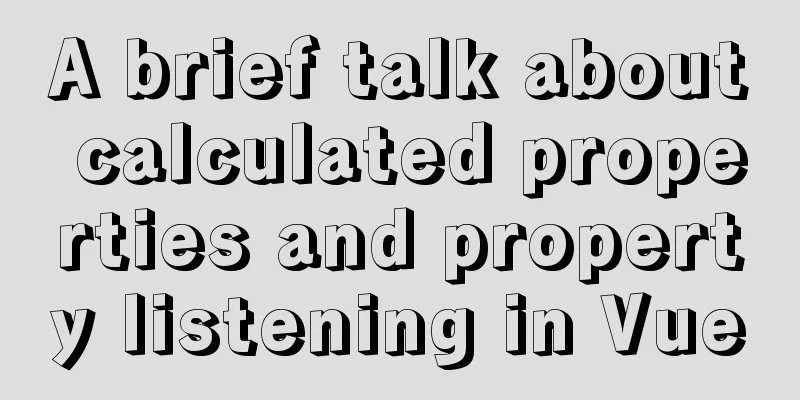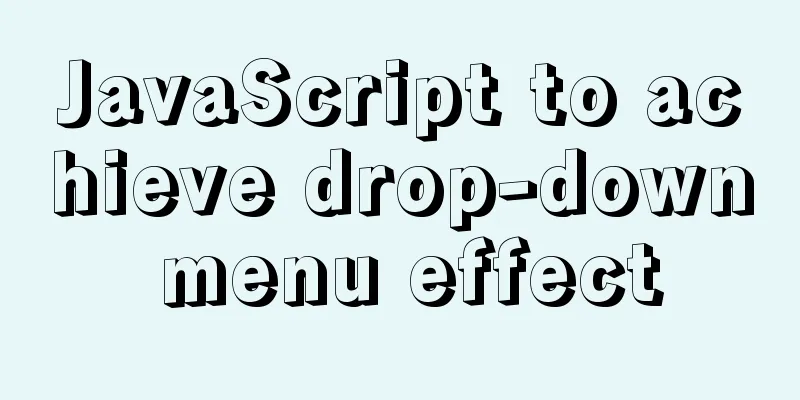A brief talk about calculated properties and property listening in Vue

1. Computed propertiesdefinition
principle
When is the get function executed?
Advantages
Remark
Syntax: 1. Abbreviated form:
computed: {
"Computed Property Name" () {
return "value"
}
}
Requirement: Find the sum of 2 numbers and display it on the page
<template>
<div>
<p>{{ num }}</p>
</div>
</template>
<script>
export default {
data(){
return {
a: 10,
b: 20
}
},
// Computed properties:
// Scenario: The value of a variable needs to be calculated using another variable/*
grammar:
computed: {
ComputedPropertyName() {
return value}
}
*/
// Note: Both computed and data attributes are variables - they cannot have the same name // Note 2: If a variable changes within a function, the result will be automatically recalculated and returned computed: {
num(){
return this.a + this.b
}
}
}
</script>
<style>
</style>
Grammar: 2. Complete writing:Computed properties are written in the format of configuration objects: get and set functions are used in objects The role of get: When someone reads fullName, get will be called and the return value will be used as the value of the calculated property (get must write return) When is get called? 1. When fullName is read for the first time. 2. When the data it depends on changes.
get(){
console.log('get was called')
// console.log(this) // this here is vm (Vue instance)
return this.firstName + '-' + this.lastName
},
set: When the value of a calculated property is modified, the parameter that is called receives the new value passed in.
...
computed:{
fullName:
//What is the function of get? When someone reads fullName, get is called, and the return value is used as the value of fullName. //When is get called? 1. When fullName is read for the first time. 2. When the data it depends on changes.
get(){
console.log('get was called')
// console.log(this) //This is vm
return this.firstName + '-' + this.lastName
},
//When is set called? When fullName is modified.
set(value){
console.log('set',value)
const arr = value.split('-')
this.firstName = arr[0]
this.lastName = arr[1]
}
}
}
})
2. Monitoring (listening) properties<!-- When binding an event: @xxx="yyy" yyy can write some simple statements --> <button @click="isHot = !isHot">Switch weather</button> 1. Monitoring attribute watch:When the monitored attribute changes, the handler callback function is automatically called to perform related operations The monitored attribute must exist before it can be monitored! !
...
//Writing method 1. Pass in watch configuration to listen to ishot attribute watch:{
isHot:{
immediate:true, //Let the handler call during initialization //When will the handler be called? When isHot changes.
handler(newValue,oldValue){
console.log('isHot has been modified', newValue, oldValue)
}
}
}
})
// Method 2. Monitor via vm.$watch('isHot',{
immediate:true, //Let the handler call during initialization, the default is false
//When is the handler called? When isHot changes.
handler(newValue,oldValue){ // There are two parameters, one is the new value and the other is the old value console.log('isHot has been modified',newValue,oldValue)
}
})
2. Deep monitoringDeep Monitoring:
Remark:
data:{
isHot:true,
numbers:
a:1,
b:1
}
},
watch:{
// Monitor the change of a certain attribute in a multi-level structure (the original writing method needs to add quotation marks, and the abbreviation can be omitted, but in this case it must be added, otherwise an error will be reported)
/* 'numbers.a': {
handler(){
console.log('a has been changed')
}
} */
//Monitor the changes of all attributes in the multi-level structure numbers:{
deep:true, // If this is not enabled, then the monitoring is whether the address of numbers has changed handler(){
console.log('numbers changed')
}
}
}
Monitoring properties - shorthand This can be abbreviated when there is only handler() in the monitoring properties and no other configuration items need to be enabled.
watch:{
isHot(newValue,oldValue){
console.log('isHot has been modified',newValue,oldValue,this)
}
}
/* vm.$watch('isHot',function (newValue,oldValue) {
console.log('isHot has been modified',newValue,oldValue,this)
}) */
3. Differences and principlesDifference between computed and watch
Two important principles
watch:{
firstName(val){
setTimeout(()=>{
console.log(this) //vue instance object, if a normal function is used, it returns Window
this.fullName = val + '-' + this.lastName
},1000);
},
lastName(val){
this.fullName = this.firstName + '-' + val
}
}
SummarizeThis is the end of this article about calculated properties and property listening in Vue. For more relevant Vue calculated properties and property listening content, please search 123WORDPRESS.COM's previous articles or continue to browse the following related articles. I hope everyone will support 123WORDPRESS.COM in the future! You may also be interested in:
|
<<: Summary of important mysql log files
>>: Detailed explanation of MySQL data rows and row overflow mechanism
Recommend
Solution to the VMware virtual machine prompt that the exclusive lock of this configuration file failed
After VMware is abnormally shut down, it prompts ...
How to open port 8080 on Alibaba Cloud ECS server
For security reasons, Alibaba Cloud Server ECS co...
Introduction to HTML_PowerNode Java Academy
What is HTML? HTML is a language used to describe...
How to avoid the trap of URL time zone in MySQL
Preface Recently, when using MySQL 6.0.x or highe...
Example code for implementing the "plus sign" effect with CSS
To achieve the plus sign effect shown below: To a...
MySQL group query optimization method
MySQL handles GROUP BY and DISTINCT queries simil...
MySQL 5.7.17 installation and configuration method graphic tutorial under Windows 10
In this article, I will explain in detail how to ...
Linux confirms that the data disk has been uninstalled and a new custom image can be created
Custom Image FAQ How to view the data disk? You c...
25 CSS frameworks, tools, software and templates shared
Sprite Cow download CSS Lint download Prefixr dow...
CSS3 uses transform-origin to achieve dot distribution on a large circle and rotation effects
First, we need to use the transform-origin attrib...
Installation tutorial of mysql5.7.21 decompression version under win10
Install the unzipped version of Mysql under win10...
Install ethereum/Ethereum from scratch under CentOS7
Table of contents Preface Add sudo write permissi...
The concept and characteristics of MySQL custom variables
A MySQL custom value is a temporary container for...
Share 9 Linux Shell Scripting Tips for Practice and Interviews
Precautions 1) Add interpreter at the beginning: ...
How to set mysql5.7 encoding set to utf8mb4
I recently encountered a problem. The emoticons o...









